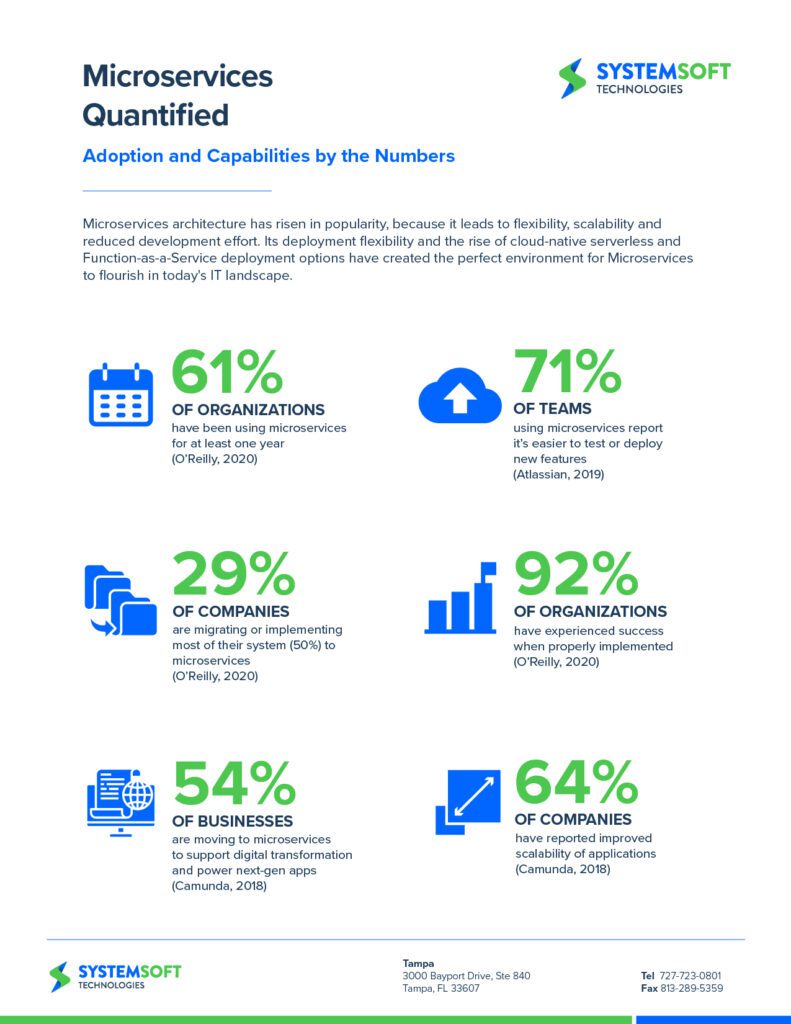If you operate in a dynamic market segment, if you’re facing competition, if speed, agility and time-to-market are important to the success of your organization, or if you have big plans and scalability is a priority, then the microservices architecture is the right way to go.
Consider that Amazon, Facebook and Google have run microservices for more than a decade. Now, those are a few of the most agile and scalable organizations to date.
These industry movers and shakers’ use of microservices have influenced 77% of businesses to adopt the innovative architecture, with 92% experiencing success, according to a recent O’Reilly survey. And, with microservices projected to grow globally at a 22.5% rate through 2025, monolith to microservices architectures are a prime topic of discussion.

Microservices in Action
A microservices architecture is an approach for writing software. It allows for breaking down apps into their smallest components, and independent from each other.
There’s an ongoing debate over monolithic versus microservices architecture. The latter has many advantages that can easily outweigh the use of monoliths. Generally, building a strong microservices strategy sets up your organization to increase productivity. It also keeps you competitive in an erratic economy and amplify revenue-driving customer experiences.

What Are Advantages of Microservices?
- By decoupling the microservice from the main app and delegating a task to a separate service, you save your application from getting potentially bigger and heavier. As a bonus, instead of one heavy process, you will have several processes with a correct server load distribution.
- If a part of your microservices ecosystem becomes a bottleneck, you are free to scale it horizontally and independently of other app components. All you should do is organize correct communication between these services. If you don’t need the microservice anymore, you can easily unplug it, without the risk of breaking something in the main app, depending on your communication type.
- All microservices require working by the black box principle. Nevertheless, you are always free to change something, if needed, to make sure there’s no overhead.
- Microservices architectural style promotes reusability. If you take care of microservices independence from the project, you will receive autonomous microservices that can be used in other projects for similar tasks.
- All microservices can be fully autonomous. Therefore, any collapse in one of them won’t affect the work of the main app. Of course, this collapse will destabilize the microservice it’s responsible for, but the rest will remain stable. Testing becomes easier when microservices are separated. You don’t have to boot the entire system to run unit tests on the microservice.
Ready to Learn More?
It’s worth saying: Microservices are more interesting to work with for developers. That said, it should also be known that microservices are a logical stage of a project’s life.
At System Soft Technologies (SSTech), we can put microservices into the best perspective for any organization. Especially, if you’re seeking business agility, efficiency, resiliency and more revenue.
To that end, we recently put together a free webinar for decision-makers and IT professionals. It gives you a foundational understanding of how the building blocks of containers, APIs and scalable cloud infrastructure can help develop a strong microservices strategy.
[Also check out: Why Cloud Governance Matters and Cloud Security: Not a Contradiction in Terms]
Our webinar is now on demand. It details how you can get products to market rapidly and create a robust debugging strategy with microservices. Specifically, you will learn about these five steps:
- Single Responsibility Principle. When one, and only one, capability is provided by a service.
- Isolation. Building and maintaining a single capability, without impacting other functions.
- Autonomy. Microservices are autonomous, so users can choose to accept or reject the promise offered by a provider but cannot direct it to behave in a particular way.
- Data Encapsulation. Microservices capture the data (or state) and behavior as a single unit, and persistent data for each service must be private, allowing user access to the data only through its published interfaces or APIs.
- Inter-process Communication. Microservices interact with each other to fulfill a user’s request or perform a business function.
[Watch webinar: Microservices: Retiring the Monolith, 5 Steps to Put Microservices in Action Now]

Act Now
After you watch the webinar, let’s talk.
Isn’t it time for your business to more quickly move forward toward true business transformation? You can, encompassing IT, processes, people and culture.
For more information, schedule your microservices QuickStrike Assessment today.
About the Author: Don Bilbrey

Don Bilbrey serves as Senior Solutions Architect at System Soft Technologies. Don, a technology nerd, knows his stuff when it comes to systems and storage solutions. He’s a people person, too. He showcases his humor and wit, as he energetically manages the service delivery needs of large enterprise customers.

